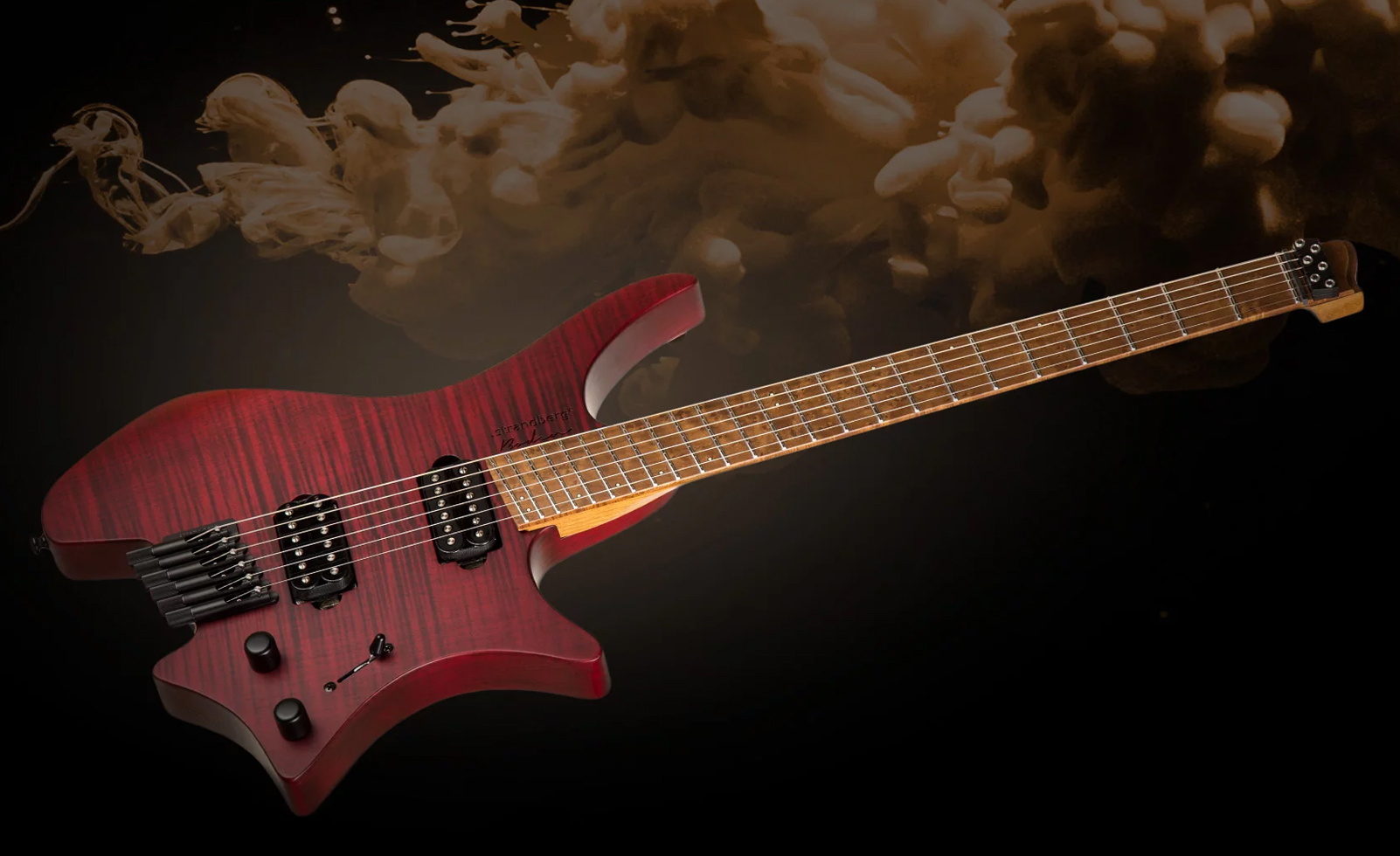Headless guitars and basses aren’t actually a new concept. They’ve been around since the 1980s, first brought to life by pioneer Ned Steinberger. Although strikingly futuristic among the traditional shapes of the Strat, Tele and Les Paul, headless guitars never really cemented themselves beyond the fleeting cultural zeitgeist of big perms, shred guitar and their appearance in cult movie, Bill and Ted’s Excellent Adventure. It’s safe to say no one predicted their return to popularity a whole three decades later, but they’re back and better than ever before whether you like them or not.
Headless Guitars: Why are they so popular?
Aside from making a great topic for guitarists to argue over, headless guitars have a number of things going for them that makes them so popular, and possibly even superior to the standard headstock design. Let’s find out why.
What is a Headless Guitar?
The difference between a headless guitar and what we’d consider a ‘standard’ guitar, is the distinct lack of a headstock. Instead, a headless design relocates all tuning hardware to the bridge area. This grants an even weight distribution across the guitar – you won’t experience any neck dive and you don’t have to worry about denting a headstock. To string a headless guitar, you simply slide the string through the bridge up to the stump end of the fretboard, screw into place at both ends and tune up. So easy anyone could do it.

Advantages of a headless guitar
- They’re light and well balanced. That means less weight to carry on your shoulder while playing standing up and a reduced chance of playing-related injuries or niggles.
- Ergonomics – the thoughtfully designed body carves and common appointment of fanned frets make for an effortless playing experience.
- Restringing is quicker and simpler thanks to the clamps at the zero fret end.
- Smaller body = less wood makes for a more environmentally friendly building process. It’s also way easier to take travelling.
- Effortless and quick pitch fine-tuning with the tuners being right next to your picking hand.
- Headstock dive isn’t a thing. You can chuck a headless guitar around and not have to worry about hitting the headstock if you’re sitting at a desk or in a small space.
Headless guitar aesthetics
Let’s address the elephant in the room. Headless guitars might not suit your stylistic tastes and they might not be for everyone. You might think they’re a little hard to love. But if you’re in the modern guitar scene and love the look and feel of a Jackson, ESP, Music Man, Ibanez or Aristedes guitar, then a headless design might suit you.
Ergonomic design
Almost every headless guitar manufacturer adopts a series of ergonomic construction techniques. They are almost always smaller than traditional guitars and utilise the chambering method to cut out unnecessary amounts of body wood to make the instrument even lighter. You’re basically saving the planet when you buy headless. That’s probably a good enough reason as any, but you’re likely after other advantages as well.
Headless guitars adopt unique shapes, meticulously designed feel like an extension of your body. They certainly won’t strain your back muscles like a heavy Les Paul. It’s compact and easy to pack in the back of a car or take on a flight. Both Ibanez and Strandberg also make use of fanned frets to shore up on intonation and fretting comfort, following the natural curvature of your hand.
Neck dive is a real problem when playing standing up with some guitars – SGs are a major perpetrator. A headless guitar stays exactly where you want it. You only have to focus on what you’re playing, rather than holding the neck up at the same time. If headless guitars were around when Angus Young started playing, I wouldn’t be surprised if he was their biggest fan with how he jumps around the stage.
Zero fret nut
Do you ever notice how a note sounds different when you play it on a fret compared to an open string? Every type of headless guitar completely solves this problem. The strings on a standard headstock guitar are tightened across what is usually a bone or plastic nut, as opposed to the rest of the notes pushed down to a nickel or steel fret. Headless guitars use a zero fret metal nut just like a normal fret for open notes, providing a more consistent sound.
Guitarists who play headless guitars
Headless guitars are usually found in the hands of prog rock and metal players in need of optimal playing comfort and a wide array of tones. Notable headless guitar users include Plini, Yvette Young, Ichika Nito, Jacob Collier, Born of Osiris’ Lee McKinney and Charlie Griffiths & Richard Henshall of prog metal band Haken. It’s not just a millennial thing: legendary musicians Allan Holdsworth, Mark Knopfler, Eddie Van Halen and Sting have all dabbled with the radical design over the years.

Popular headless guitar brands
Just a few of the names championing the eye-catching shape include Swedish trendsetters Strandberg, Japanese behemoths Ibanez, Sire, and even originators Steinberger. Also joining these established guitar builders is the newcomer brand HILS.
HILS Guitars
HILS Guitars – part of renowned Korean guitar maker HEX – use innovative manufacturing methods that enable them to build a diverse range of affordable, high-quality instruments without compromise. Their range of headless guitars combine carefully-calculated body curves with premium features like Roasted Maple necks and ceramic pickups with push-pull circuitry. This guarantees a versatile tonal range that’s perfect for everything from your go-to performance guitar to the ultimate practice companion.
Strandberg Guitars
Strandberg stands for the fact that not just the sound of your guitar, or how it feels to play are important components, but also how it makes you feel. Strandberg design innovative headless guitars which push the boundaries of guitar creation, and due to their lightweight ergonomic design with modern features, they are highly regarded as one of best playing experiences out there, especially thanks to the signature Endurneck.
The Strandberg Essential is the more affordable range which covers all musical styles for the open-minded musician. Representing the core of Strandberg’s ranges is the Boden & Standard. The Boden & Standard push the boundaries of guitar innovation, while the Metal & Prog range is for players who need crushing impactful tone with a solid playing experience.
The Sälen is thoughtful synthesis of the retro-classic and cutting-edge design. Classic tonewoods and construction techniques with modern design and radical features meld cohesively together into a seamless whole.
Ibanez Quest Series
The Ibanez Quest Series boldly announced itself in the headless scene a few years ago and it’s proven to be a massive hit. They bring a playful new look, cool collection of woods like bubinga-made necks and roasted maple fretboards, and all your fun touches like Luminlay side dots, hard-wearing Jescar fretwire and the famous, super flat Wizard neck profile. The pickups are developed from the ground up, designed specifically for the Quest to sound clearly defined and balanced for all your extended chords and nuances. They’re extremely versatile too, thanks to the switching system giving you 10 pickup variations, including single-coil modes.
Sire Larry Carlton X6 Series
Browse Sire Larry Carlton X6 Series
Sire made a huge splash in the guitar world with their Larry Carlton guitars – a catalogue designed in collaboration with the renowned guitarist who has played for the likes of Steely Dan and Joni Mitchell. The X6 however is unlike any of their other guitar shapes, fitted with just about everything the modern guitarist would love to have, like their famed rolled fretboard edges, fanned, stainless steel frets, relatively flat 16 inch fingerboard radius and modern sounding humbuckers. It’s a sleek, attractive, and even quite understated design, which might appeal to the players who like the idea of a headless guitar, but can’t get on board with many other brands’ designs. The inlays are unique and the little smattering of gold in the hardware brings a touch of class.
Summary of headless guitars
The headless guitars design philosophy turns traditional guitar construction on its head. It’s about more than just the relocation of the tuners to the bridge – it is a refocus of what is helpful to a guitarist from an ergonomic perspective. How should a guitar fit against your body? Is it comfortable playing sitting down and standing up? Where should your hand rest on the neck? And how tonally diverse can a guitar get without compromising quality? These are issues that headless guitar makers concern themselves with.
Floating bridge systems, 6, 7 or 8, strings, various pickup configurations, hollow and solid body construction – you name it, a headless guitar can do it. The final thing it comes down to is whether you love how they look.
Want to Learn More?
If you enjoyed this read, check out more of our Learn blogs.




Responses & Questions